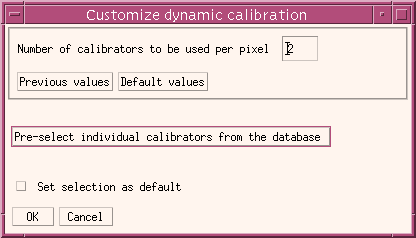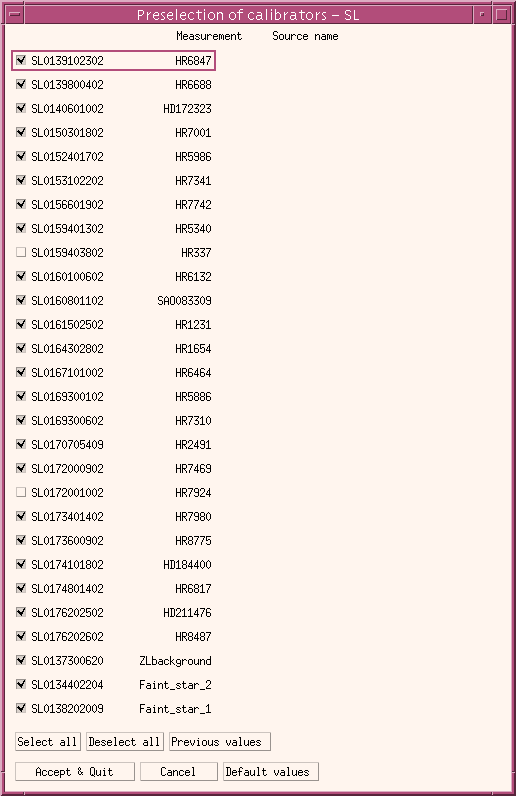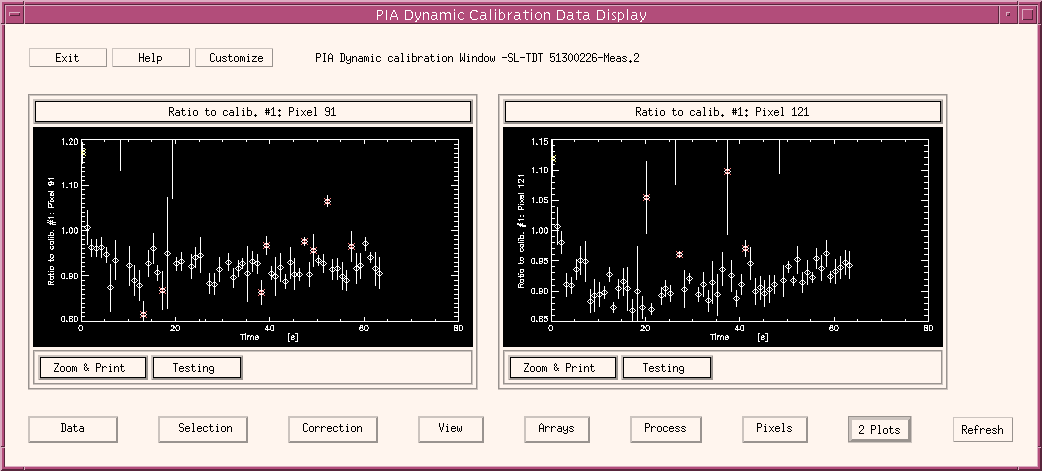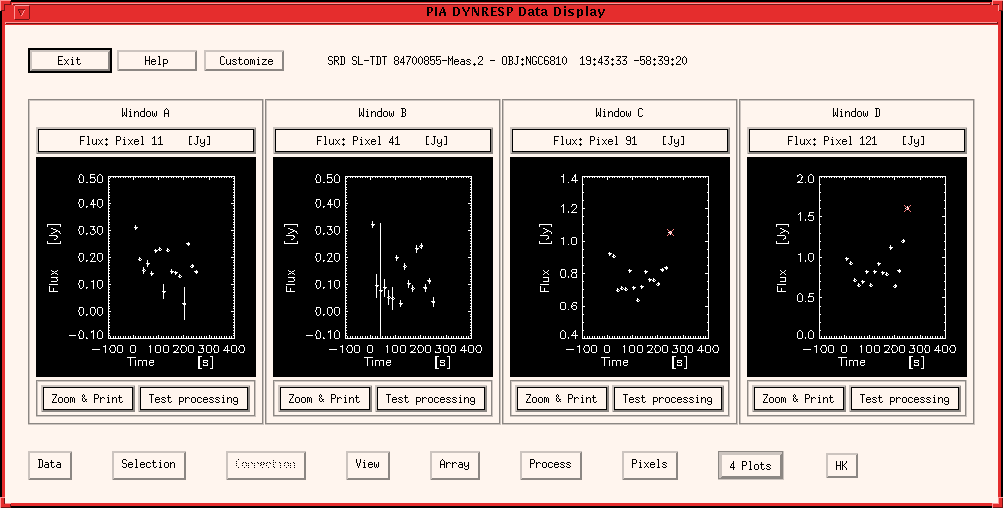3.3.8) The PIA dynamic calibration and the dynamic response methods (for
PHT-S staring measurements)
PIA offers the user (from version 7.3 on) an alternative way of calibrating
data from staring PHT-S observations. The method of the dynamic calibration
for
staring PHT-S observations based on a direct comparison of the signal time
evolution between the observed target and known calibrators. Based on this,
the PIA Dynamic Response method was developed, to make possible such a
correction in both the PHT-Offline Processing system and the PIA AOT/Batch
mode.
The idea behind the method, suggested originally by Linda Cornwall (RAL)
was worked out by Garzon and Hammersley (both IAC) and proposed to the
PIA development team. The full implementation (including the corresponding
PIA GUI) was performed by Jose Acosta Pulido (ESA/IAC).
Basics of the dynamic calibration method
The basic assumption of the dynamic calibration is that the transients
behaviour (eg temporal response) of an individual pixel depends primarily
on the flux level observed with a high reproducibility under a similar
illumination history of the detector. The fact, that PHT-S observations
(AOT P40) are always performed in the same way (source observation
preceded by a short dark exposure), implies in most cases a very similar
history and makes observations with this PHT subsystem specially suitable
for this method.
A comparison of the signals achieved by the target to the ones achieved
by different calibrators after same time intervals within an observation
allows a discrimination of the most closed calibrators in flux to the target.
The ratios obtained are then used for deriving the unknown target flux.
A database containing a large number of measurements of well known sources
covering a wide range in flux was implemented, taking into account that
preliminary tests have shown thath the drift behaviour of a given pixel
remains similar for a flux range of 0.5 magnitudes.
Database generation
A series of observations on calibration stars, covering a range of magnitudes
from mk = -3.08 to mk
= 7.54 was reduced in a standard way to the signal level
using PIA procedures and the time evolution of the signals fitted with
Chebyshev polynomials of different degrees (Chebyshev polynomials are a
good approximation to the minimum degree polynomial which deviates less
from a given function). A look-up table of the values at different pre-determined
measurement times (after 16s, 32s, 64s, 128s, 256s) can then be used for
a quick selection of the best matching calibrators for each pixel of a
given target.
Flux assignment
The flux calibration is done in this method by taking the ratio between
the signals from the target and the calibrator along the observing time
and then deriving the mean and median values, which are scaled by the known
flux from the calibrator chosen. The dark current subtraction should be
performed previously to the dynamic calibration application (PIA gives
a warning in case it has not been done).
Since the time evolution of the response for a given pixel is determined
mainly by the illumination level NO background subtraction to the observed
target should be done. Therefore the total flux (source plus background)
of each calibrator has to be computed. The stellar models provided by M.
Cohen and P. Hammersley are used for computing the flux of the calibration
stars, while the background to be added was estimated from modelling Zodiacal
Light (which is the dominating background at the PHT-S wavelengths) with
an emission component (blackbody of T=267 K) plus a reflection component
(BB of T=6000K). The relative scaling of the two components was done using
COBE/DIRBE weekly averaged measurements at bands matching the PHT-S wavelengths.
The PIA GUI for dynamic calibration
The dynamic calibration processing can be started at the main SRD level
window under the option Processing -> dynamic calibration or -> dynamic
calibration -> customize. If the customize option is chosen, an intermediate
menu, as shown in Fig. 1 will appear, which
allows the user to set the number of best matching calibrators to be used
(default is 2) as well as to make a pre-selection of calibrators. If a
pre-selection is to be made, then a list of calibrators with their
status as active or inactive will appear, as shown in Figure
2. The selection corresponding to this figure is the default one at
the time of releasing PIA V7.3.

FIGURE 1: Customizing the dynamic calibration

FIGURE 2: Pre-selection of calibrators
Once a choice has been taken (or the defaults by-passing the menues
described above) following processing will be performed by PIA:
Selection of calibration sources: the best matching calibrators for every
pixel independently are found based on the singals measured at 16, 32,
64, 128 and 256 seconds. More weighting is given to signals after advanced
exposure time.
The ratio of target singals to calibrator modelled singals (Chebyshev expansion)
for the common observing time are computed. Mean and median yeld to the
flux scaling factor. The best calibration is obtained when the ratio along
time is constant and close to unity. Discarded points (glitches, first
measured signal, etc) from the target are not included. The fraction of
the measurement which is used to compute the ratio can be selected a posteriori
interactively.
Further processing will proceed through the main dynamic calibration
window (Fig. 3). It is similar to all main levels'
PIA windows. The main variables plotted are the ratios between source signal
and calibrators used. It is possible to toggle between the different calibrators,
as well as to observe the signals themselves, flags, etc.

FIGURE 3: Main window for dynamic calibration
Since many features of this window are common to all PIA main windows,
we are not going to discuss them in detail. The fundamental elements here
are:
inspecting which calibrators have been used for every pixel (under View),
producing 'spectra' from the chosen calibrator fluxes themselves (under
Arrays). In this case a spectrum is generated, using for every pixel the
flux corresponding to the chosen calibrators (the user has the possibility
of taking the first, second choice, etc).
processing the data to the AAP level (Process) by using one of the following
methods for the combination of the ratios obtained to the different calibrators:
No weight - All calibrators have the same weight
According to signal ratio - More weight is assigned to the calibrator with
the signal ratio closer to unity
According to ratio uncertainty - Larger weight is assigned to those calibrators
whose signal ratio have a smaller uncertainty.
The PIA Dynamic Response Method:
Using PIA, a method was developed, which made possible the inclusion of
the dynamic calibration concepts into a pipeline type processing. It is
based in the interpolation of all the temporal behaviours of the signals
for the different calibration observations (thus covering the whole accessible
flux range). The resulting surfaces derived for each PHT-S pixel
contain the interpolated expected flux for each time / signal combination.
They had to be extrapolated to those regions which were not directly observed
(eg large times for high fluxes).
An observation is calibrated in the following way: for each time
and each signal the corresponding flux is determined in the 'calibration
surface'. All the fluxes corresponding to the different times are then
used for averaging. A classical PIA data window as shown below give
access to the full distributions for judgement of the stability of the
method in the case of interactive derivation. The main application of this
method resides however in its inclusion in the AOT/Batch mode, since the
results should not differ basically from the ones obtained with the full
interactive dynamic calibration, performed with the default calibrators
choice.

FIGURE 4: Main window for dynamic response calibration
Chapter history:
| Date |
Author |
Description |
| 05/12/1998 |
Carlos GABRIEL (ESAVILSPA-SAI) |
First Version (PIA V7.3) - (Based on J.Acosta's internal PIDT document
'Dynamic Calibration for ISOPHOT-S') |
| 02/11/1999 |
Carlos GABRIEL (ESA-VILSPA) |
Change in chapter numbering (V8.1) |
| 17/03/2000 |
Carlos GABRIEL (ESA-VILSPA) |
Update (inclusion of dynamic response) (V8.2) |




